Experimental Study on the Influence of Interfacial Energy Instability on the Flow Pattern Spatiotemporal Evolution of Thermal- Buoyant Capillary Convection
Abstract
1. Introduction
2. Materials and Methods
- Select the upper and lower disks of the liquid bridge with the determined diameter (5.12 mm), fix the capillary thermocouple on the lower disk and connect it to the multi-channel temperature collector.
- Connect the macro close focus lens to the front of the high-speed camera window through the adapter ring.
- Mix the appropriate amount of PF tracer particles with 10cSt silicone oil. Long-time physical oscillation is carried out through a vortex mixer to ensure that the particles are uniformly distributed in the silicone oil.
- Adjust the relative height of the upper and lower disks of the liquid bridge to 2.0 mm and inject silicone oil mixed with tracer particles through the micro syringe pump.
- Turn on the laser generator, fix the laser transmitter at a certain incident angle (the laser plane is in a fan shape, the thickness of the laser plane is 0.5 mm, and the included angle is 60°) and record the volume of the liquid bridge formed, V.
- Set the coil spring heater to a certain overheat temperature to heat the upper disk of the liquid bridge and record the temperature changes in the hot corner area and the middle high position in the experiment online.
- Adjust the GTA to 0°, 5° and 10°, and repeat steps a–f for the experiment.
- Import the experimental video into PIV post-processing software. Extract the distance, displacement and velocity information of the flow field based on the scale of the digital image and the actual distance.
3. Results and Discussion
3.1. Influence of Interfacial Energy Instability under Different GTAs on the Flow Pattern Spatiotemporal Evolution of TBCC
3.1.1. Steady Stage of Thermal-Buoyancy Capillary Convection
3.1.2. Oscillation Stage of Thermal-Buoyancy Capillary Convection
3.2. Influence of Interfacial Energy Instability on the Distribution of Velocity Field in TBCC under Different GTAs
3.2.1. Influence of Different GTAs on the Distribution of Transverse Velocity Components
- (1)
- Steady stage of thermal-buoyancy capillary convection
- (2)
- Oscillation stage of thermal-buoyancy capillary convection
3.2.2. Influence of Different GTAs on the Distribution of Longitudinal Velocity Components
- (1)
- Steady stage of thermal-buoyancy capillary convection
- (2)
- Oscillation stage of thermal-buoyancy capillary convection
4. Conclusions
- (1)
- With the application of the GTA, the left and right interface shapes of the liquid bridge gradually become unbalanced, the curvature radius of the interface on the left (on the far ground side) decreases, and the concave degree of the interface on the right (on the near ground side) increases. Compared with the condition of φ = 0°, the development of cell flow is obviously suppressed in the stable TBCC under GTA of 5° and 10°, but the cell flow morphology still presents an axisymmetric liquid bridge morphology. The left-cell flow (on the far ground side) distorts, and the vortex core morphology is long, narrow and flat. In the oscillating TBCC, the cell flow morphology is restrained, and the deviation of left and right cell flow vortex cores from the intermediate height (y = 1.2 mm) is gradually increased under the application of the GTA, and the scope of the alternating flow in the middle part of the liquid bridge gradually expands.
- (2)
- Furthermore, the Bo′ydn remains unchanged under the condition of φ = 0°. Conversely, when GTA is φ = 5° or φ = 10°, the Bo′ydn gradually decreases (Bo′ydn,5°= 0.041→0.039→0.037 and Bo′ydn,10° = 0.035→0.034→0.033) with the development of oscillating TBCC. The transverse and longitudinal velocity component at different heights is suppressed, and the position of the velocity peak gradually approaches that of the free interface. In the oscillating TBCC, the disturbance of transverse/longitudinal velocity component is significantly suppressed over time by the GTA, and the distribution of the longitudinal velocity component along the radial direction changes from the multi-peak morphology to the “two peaks and one valley” morphology (“M”-type).
- (3)
- With the application of gravitational inclination, the dynamic Bond number gradually decreases (Bo′dyn < 1), the oscillation period of TBCC gradually increases (T5° = 0.46 s <T10° = 0.53 s), and the critical temperature difference of oscillating TBCC increases gradually (ΔTcr,0° = 46.1°C < ∆Tcr,5° = 48.9°C < ΔTcr,10° = 56.2°C). Additionally, Macr increases from Macr,5° = 9.36 to Macr,10° = 10.76, therefore, interfacial energy instability delayed the onset of the oscillating TBCC.
Author Contributions
Funding
Institutional Review Board Statement
Informed Consent Statement
Data Availability Statement
Conflicts of Interest
References
- Fukuda, Y.; Ogasawara, T.; Fujimoto, S.; Eguchi, T.; Motegi, K.; Ueno, I. Thermal-flow patterns of m=1 in thermocapillary liquid bridges of high aspect ratio with free-surface heat transfer. Int. J. Heat Mass Tran. 2021, 173, 121196. [Google Scholar] [CrossRef]
- Jayakrishnan, R.; Tiwari, S. Dynamic mode decomposition of oscillatory thermo-capillary flow in curved liquid bridges of high Prandtl number liquids under microgravity. Adv. Space Res. 2021, 68, 4252–4273. [Google Scholar] [CrossRef]
- Chen, Q.S.; Hu, W.R. Influence of liquid bridge volume on instability of floating half zone convection. Int. J. Heat Mass Tran. 1998, 41, 825–837. [Google Scholar] [CrossRef]
- Chen, Q.S.; Hu, W.R.; Prasad, V. Effect of liquid bridge volume on the instability in small Prandtl number half zones. J. Cryst. Growth 1999, 203, 261–268. [Google Scholar] [CrossRef]
- Kuhlmann, H.C.; Nienhüser, C.; Rath, H.J.; Yoda, S. Influence of the volume of liquid on the onset of three-dimensional flow in thermocapillary liquid bridges. Phys. Fluids 2002, 29, 639–644. [Google Scholar] [CrossRef]
- A Fan, J.G.; Liang, R.Q. Numerical Simulation of Thermocapillary convection in a half-zone liquid bridge model with large aspect ratio under microgravity. Symmetry 2022, 3, 452. [Google Scholar] [CrossRef]
- Le, C.C.; Liu, L.J.; Li, Z.Y. Oscillatory thermocapillary convection in deformed half zone liquid bridges of low Prandtl number fluids. Int. Commun. Heat Mass 2021, 127, 105499. [Google Scholar] [CrossRef]
- Brulin, S.; Tropea, C.; Roisman, I.V. Pinch-off of a viscous liquid bridge stretched with high Reynolds numbers. Colloid Surf. A. 2020, 587, 124271. [Google Scholar] [CrossRef]
- Meseguer, J.; Espino, J.L.; Perales, J.M.; Laverón-Simavilla, A. On the breaking of long, axisymmetric liquid bridges between unequal supporting disks at minimum volume stability limit. Eur. J. Mech. B-Fluid 2003, 22, 355–368. [Google Scholar] [CrossRef]
- Lapuerta, V.; Laverón-Simavilla, A.; Rodríguez, J. Stability of liquid bridges subject to an eccentric rotation. Adv. Space Res. 2008, 44, 2137–2144. [Google Scholar] [CrossRef]
- Laverón, S.A.; Perales, J.M. Equilibrium shapes of non-axisymmetric liquid bridges of arbitrary volume in gravitational fields and their potential energy. Phys. Fluids 1995, 6, 1204–1213. [Google Scholar] [CrossRef]
- Laverón, S.A.; Checa, E. Effect of a lateral gravitational field on the nonaxisymmetric equilibrium shapes of liquid bridges held between eccentric disks and of volumes equal to those of cylinders. Phys. Fluids 1997, 9, 817–822. [Google Scholar] [CrossRef]
- Lowry, B.J. Modes of nonaxisymmetry in the stability of fixed contact line liquid bridges and drops. J. Colloid Interf. Sci. 2000, 224, 28–46. [Google Scholar] [CrossRef] [PubMed]
- Ataei, M.; Tang, T.; Amirfazli, A. Motion of a liquid bridge between nonparallel surfaces. J. Colloid Interf. Sci. 2017, 492, 218–228. [Google Scholar] [CrossRef]
- Bian, X.H.; Huang, H.B.; Chen, L. Influence of liquid bridge formation process on its stability in nonparallel plates. Rsc. Adv. 2020, 10, 20138–20144. [Google Scholar] [CrossRef]
- Rodriguez, J.; Lapuerta, V.; Laveron-Simavilla, A.; Cordero-Gracia, M. Experimental and numerical analysis of non-symmetric breakage of liquid columns in an axial gravitational field rotating around an eccentric axis. Adv. Space Res. 2014, 53, 63–70. [Google Scholar] [CrossRef]
- Le, C.; Liu, L.; Li, Z. Numerical investigation of the effect of rotation on the oscillatory thermocapillary convection and dopant transport in a silicon liquid bridge. J. Cryst. Growth 2019, 523, 125149. [Google Scholar] [CrossRef]
- Wu, D.L.; Zhou, P.; Wang, G.; Zhao, B.J.; Howes, T.; Chen, W. Modeling of capillary force between particles with unequal contact angle. Powder Technol. 2020, 376, 390–397. [Google Scholar] [CrossRef]
- Wang, Y.; Zeng, Z.; Liu, H.; Zhang, L.Q.; Yin, L.M.; Xiao, Y.; Liu, Y. Flow instabilities in thermocapillary liquid bridges between two coaxial disks with different radii. Int. J. Heat Mass Tran. 2022, 183, 122182. [Google Scholar] [CrossRef]
- Chen, J.; Wang, P.P.; Li, M.R.; Shen, J.H.; Howe, T.; Wang, G. Rupture distance and shape of the liquid bridge with rough surface. Miner. Eng. 2021, 167, 106888. [Google Scholar] [CrossRef]
- Yang, S.; Qin, D.C.; Zhang, Y.P.; Xu, L.; Fu, Y.D.; Cui, J.; Pan, H. Experimental study on the influence of gravitational tilt angle on the spatio-temporal evolution of solutocapillary convection. Symmetry 2022, 12, 2485. [Google Scholar] [CrossRef]
- Kang, Q.; Duan, L.; Hu, W.R. Experimental study of surface deformation and flow pattern on buoyant-thermocapillary convection. Microgravity Sci. Tec. 2004, 15, 18–24. [Google Scholar] [CrossRef]
- Ciappi, L.; Stebel, M.; Smolka, J.; Cappietti, L.; Manfrida, G. Analytical and Computational Fluid Dynamics Models of Wells Turbines for Oscillating Water Column Systems. J. Energy Resour. Technol. 2022, 144, 050903. [Google Scholar] [CrossRef]
- Chen, K.P. Interfacial energy balance equation for surface-tension-driven Bénard convection. Phys. Rev. Lett. 1997, 78, 4395–4397. [Google Scholar] [CrossRef]
- Rice, O.K. Molecular theory of gases and liquids. J. Am. Chem. Soc. 1955, 77, 2031–2032. [Google Scholar] [CrossRef]



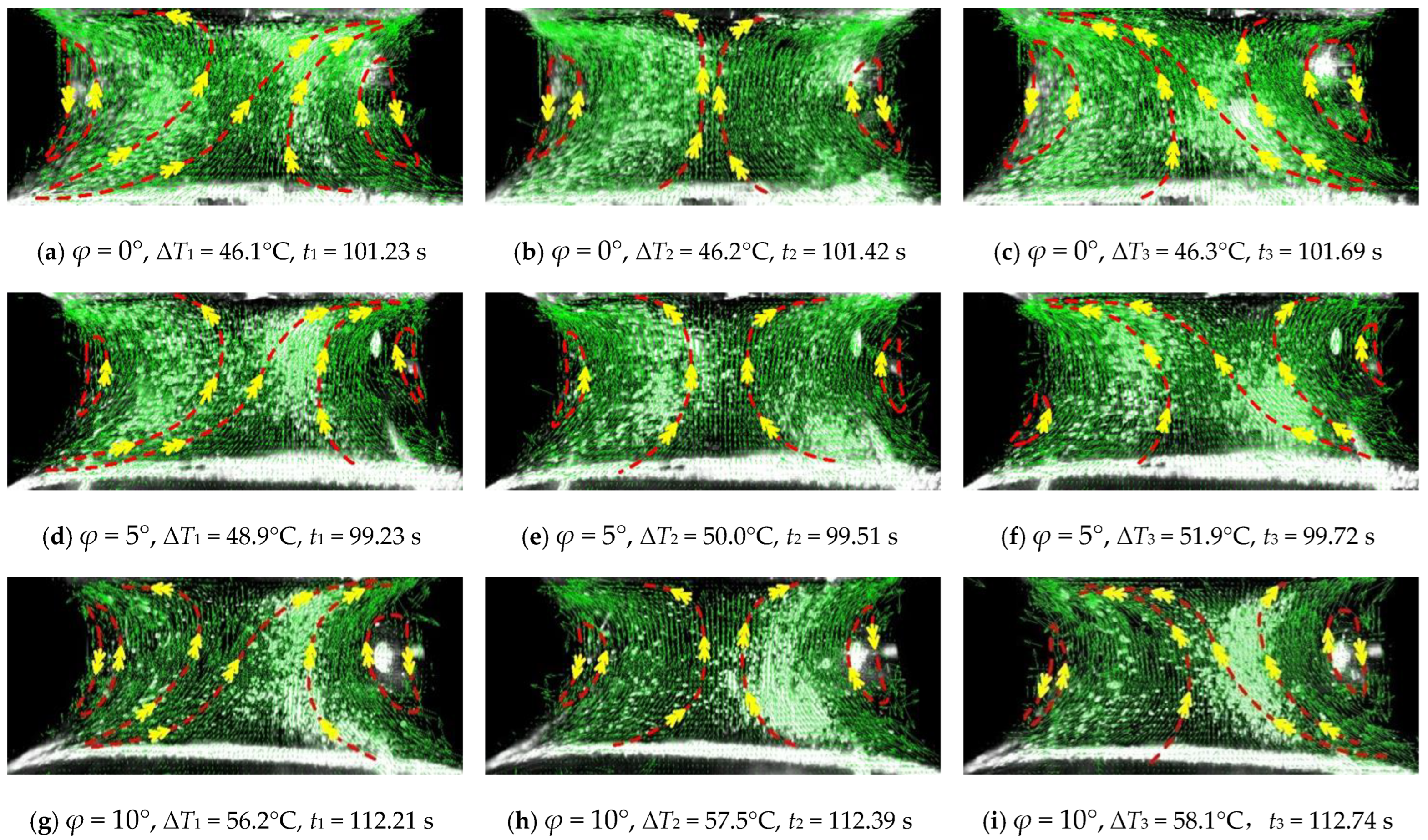
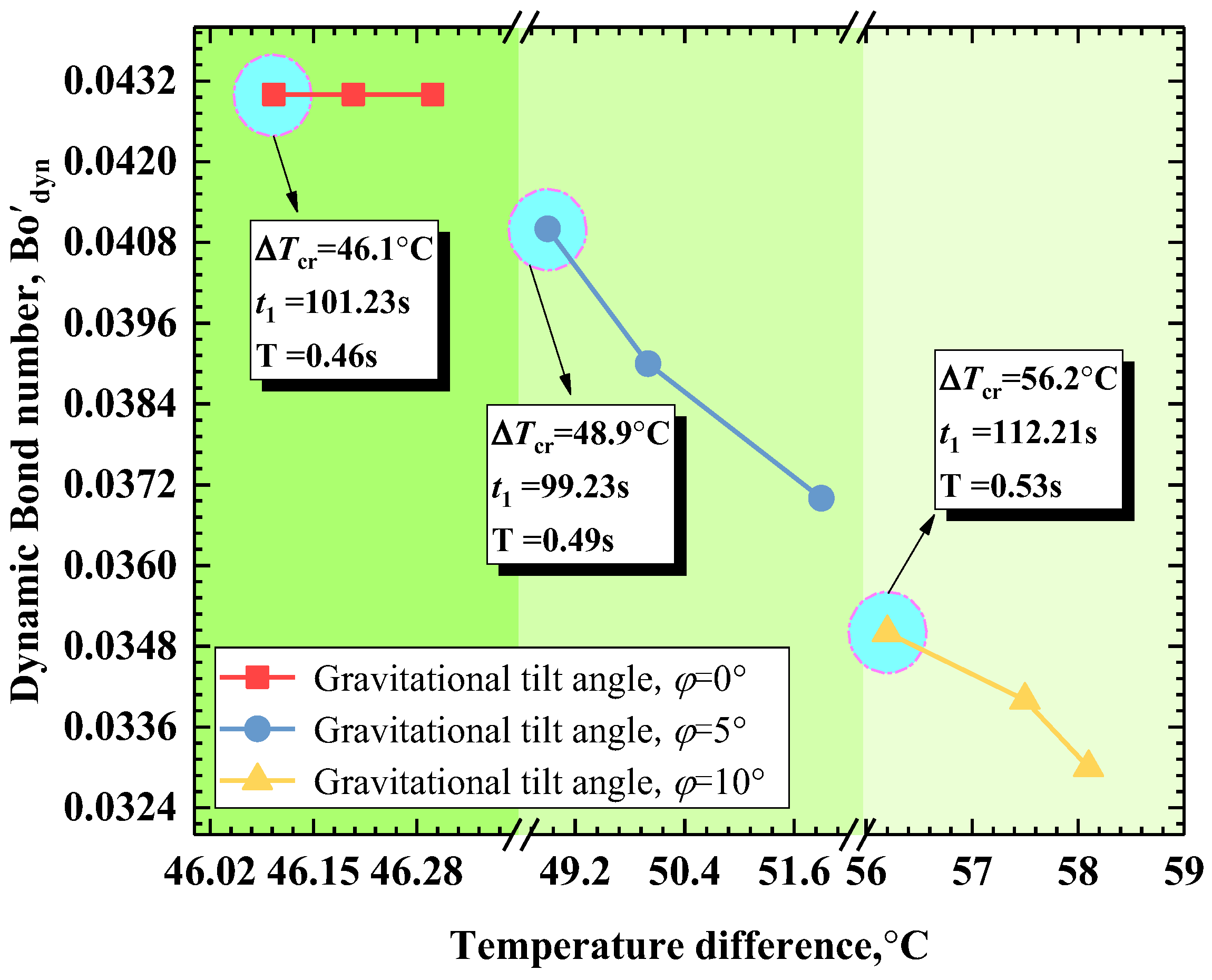

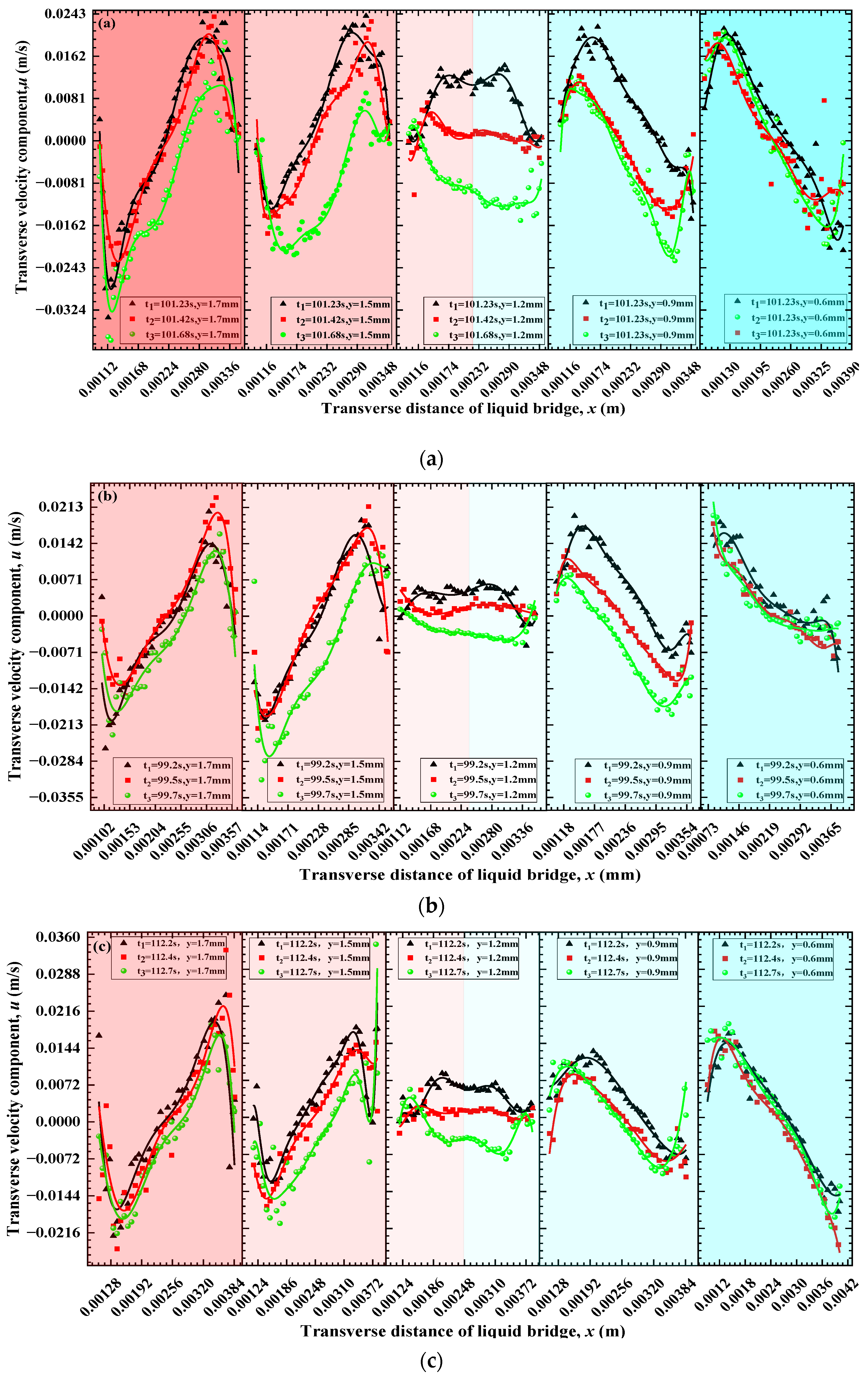

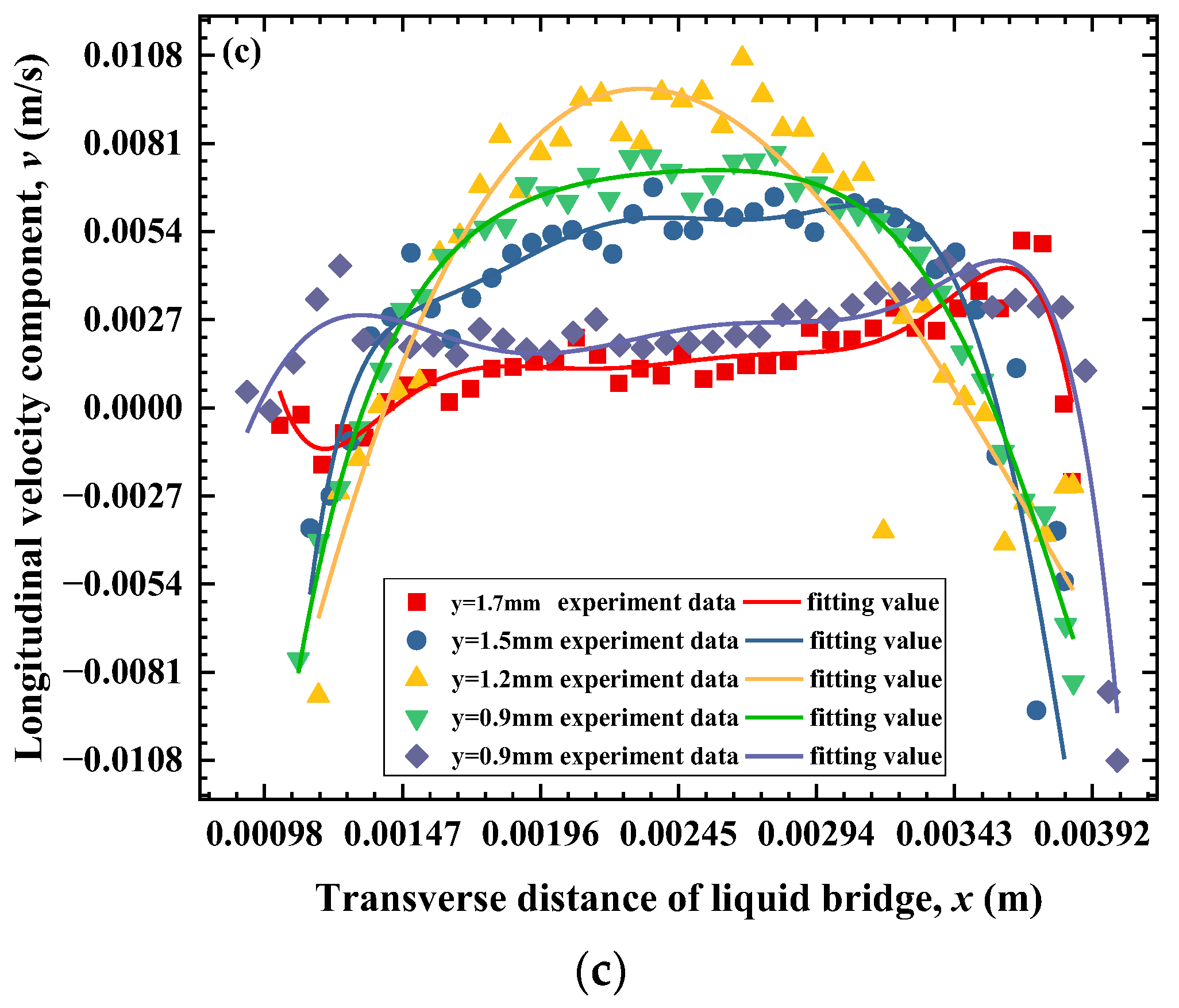
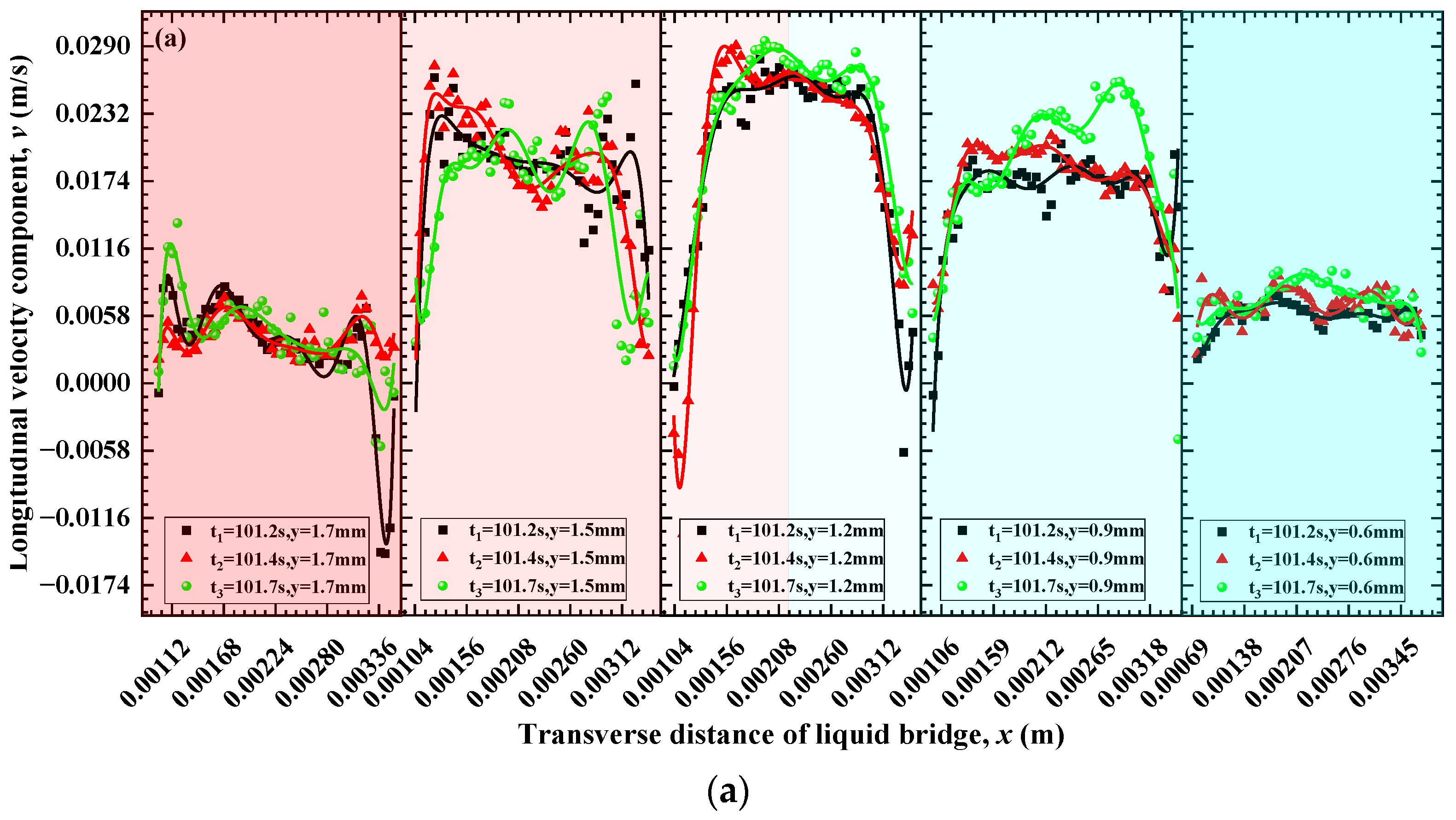


| Parameters | Unit | KF96-10cSt |
|---|---|---|
| Density,ρ | [kg/m3] | 940 |
| Kinematic viscosity,ν | [m2/s] | 10 |
| Dynamic viscosity,μ | [Pa·s] | 9.4× 10−3 |
| Refractive index,β | [–] | 1.399 |
| Thermal expansion rate,γ | [1/°C] | 1.06 × 10−3 |
| Thermal conductivity,κ | [W/m·K] | 0.14 |
| Thermal diffusivity,α | [m2/s] | 8.91 × 10−8 |
| Surface tension,σ | [N/m] | 0.0201 |
| Specific heat, Cp | [J/(kg·°C)] | 1672 |
| Parameters | Unit | PF |
|---|---|---|
| Diameter, d | [μm] | 8.5 |
| Density, ρ | [g/cm3] | 3.43 |
| Refractive index, β | [–] | 2.0 |
| Maximum flow velocity, | [m/s] | 1.6 × 10−3 |
| Stokes number, St | [–] | 1.12 × 10−8 |
| No. | Actual Volume of Liquid Bridge, V (μL) | Critical Temperature Difference in Corner Region, ΔTcr (°C) | Oscillation Period, T (s) | Interface Average Velocity in Hot Corner Region, V (m/s) |
|---|---|---|---|---|
| 1 | 23 | 38.5 | 0.8 | 20.0 × 10−3 |
| 2 | 24 | 39.1 | 0.8 | 15.0 × 10−3 |
| 3 | 24 | 40.1 | 0.9 | 15.0 × 10−3 |
| 4 | 23 | 38.4 | 0.8 | 17.5 × 10−3 |
| 5 | 23 | 39.6 | 0.7 | 20.0 × 10−3 |
| Mean value | 23.4 | 39.1 | 0.8 | 17.5 × 10−3 |
| Mean square error | 0.24 | 0.6 | 6 × 10−3 | 2.2 × 10−3 |
| GTA | Positive Peak of Transverse Velocity Component, umax (m/s) | |||
|---|---|---|---|---|
| Height, y = 1.7 mm | Height, y = 1.5 mm | Height, y = 0.9 mm | Height, y = 0.6 mm | |
| 0° | 0.01092 | 0.00917 | 0.00438 | 0.00807 |
| 5° | 0.01179 | 0.00923 | 0.00495 | 0.00711 |
| 10° | 0.00711 | 0.00501 | 0.00273 | 0.00526 |
| GTA | Absolute Peak Value of Transverse Velocity Component, |umax| (m/s) | |||
|---|---|---|---|---|
| Height, y = 1.7 mm | Height, y = 1.5 mm | Height, y = 0.9 mm | Height, y = 0.6 mm | |
| 0° | 0.01035 | 0.00801 | 0.00561 | 0.00948 |
| 5° | 0.00785 | 0.00907 | 0.00596 | 0.00872 |
| 10° | 0.00465 | 0.00495 | 0.00367 | 0.00633 |
| GTA | The Peak Value of Longitudinal Velocity Component, vmax (m/s) | ||
|---|---|---|---|
| y = 1.5 mm | y = 1.2 mm | y = 0.9 mm | |
| 0° | 0.01143 | 0.0147 | 0.01016 |
| 5° | 0.00809 | 0.01357 | 0.01022 |
| 10° | 0.00621 | 0.00977 | 0.00728 |
Disclaimer/Publisher’s Note: The statements, opinions and data contained in all publications are solely those of the individual author(s) and contributor(s) and not of MDPI and/or the editor(s). MDPI and/or the editor(s) disclaim responsibility for any injury to people or property resulting from any ideas, methods, instructions or products referred to in the content. |
© 2023 by the authors. Licensee MDPI, Basel, Switzerland. This article is an open access article distributed under the terms and conditions of the Creative Commons Attribution (CC BY) license (https://creativecommons.org/licenses/by/4.0/).
Share and Cite
Zhang, S.; Liang, R.; Yang, S. Experimental Study on the Influence of Interfacial Energy Instability on the Flow Pattern Spatiotemporal Evolution of Thermal- Buoyant Capillary Convection. Symmetry 2023, 15, 506. https://doi.org/10.3390/sym15020506
Zhang S, Liang R, Yang S. Experimental Study on the Influence of Interfacial Energy Instability on the Flow Pattern Spatiotemporal Evolution of Thermal- Buoyant Capillary Convection. Symmetry. 2023; 15(2):506. https://doi.org/10.3390/sym15020506
Chicago/Turabian StyleZhang, Shuo, Ruquan Liang, and Shuo Yang. 2023. "Experimental Study on the Influence of Interfacial Energy Instability on the Flow Pattern Spatiotemporal Evolution of Thermal- Buoyant Capillary Convection" Symmetry 15, no. 2: 506. https://doi.org/10.3390/sym15020506
APA StyleZhang, S., Liang, R., & Yang, S. (2023). Experimental Study on the Influence of Interfacial Energy Instability on the Flow Pattern Spatiotemporal Evolution of Thermal- Buoyant Capillary Convection. Symmetry, 15(2), 506. https://doi.org/10.3390/sym15020506










